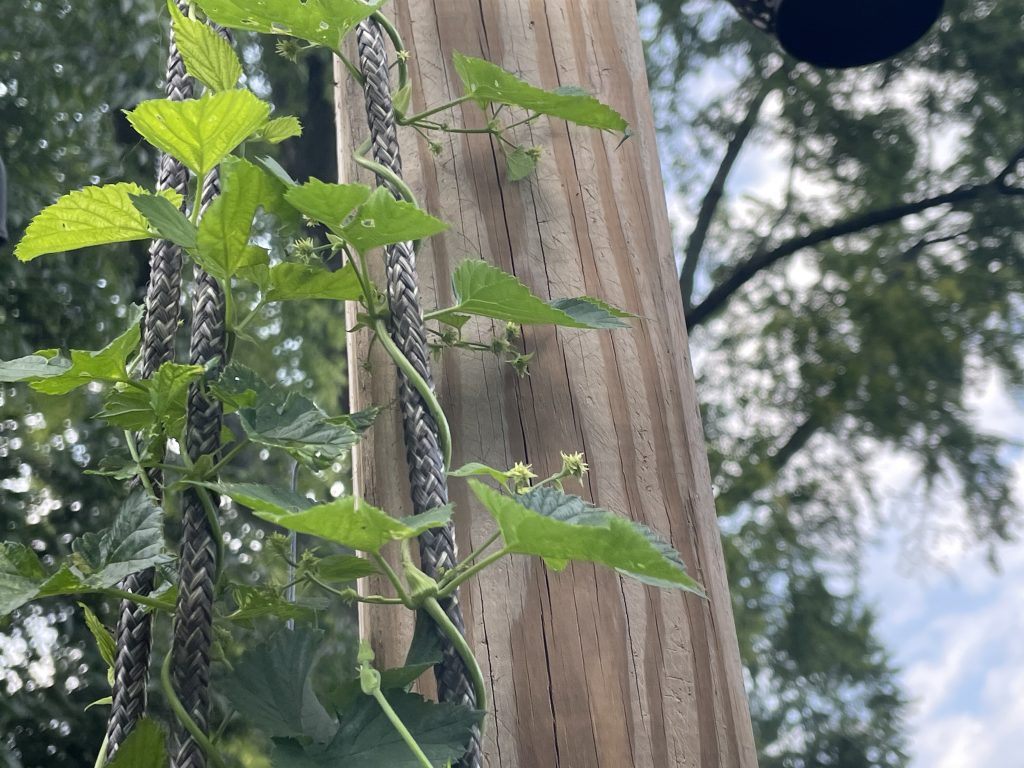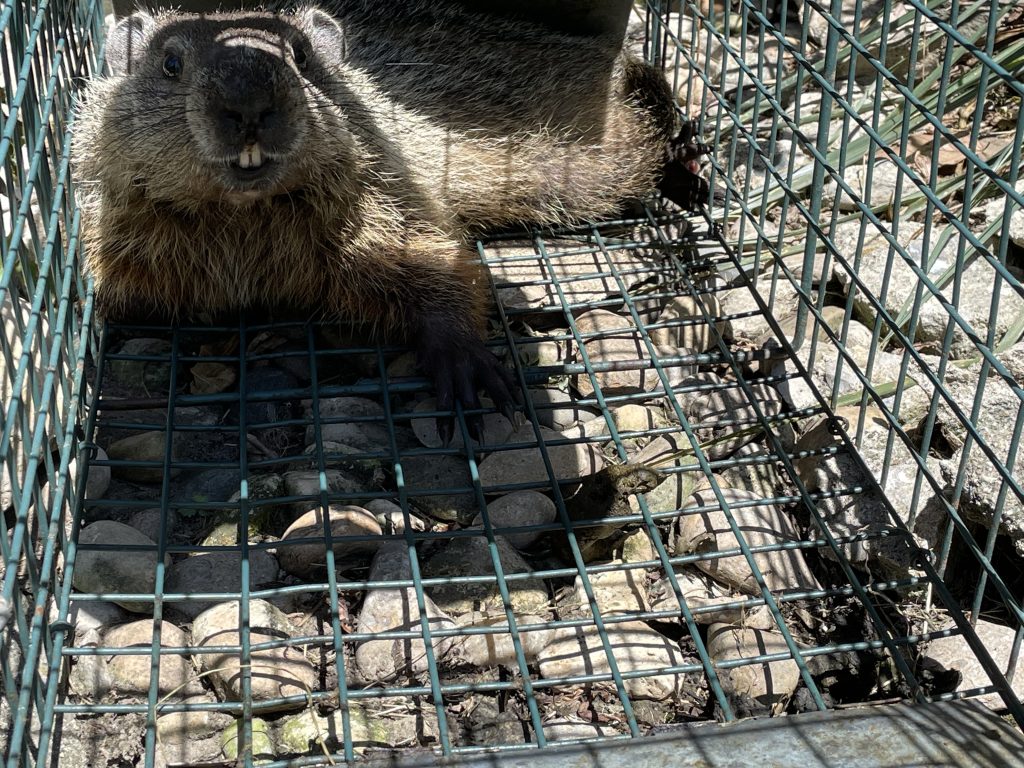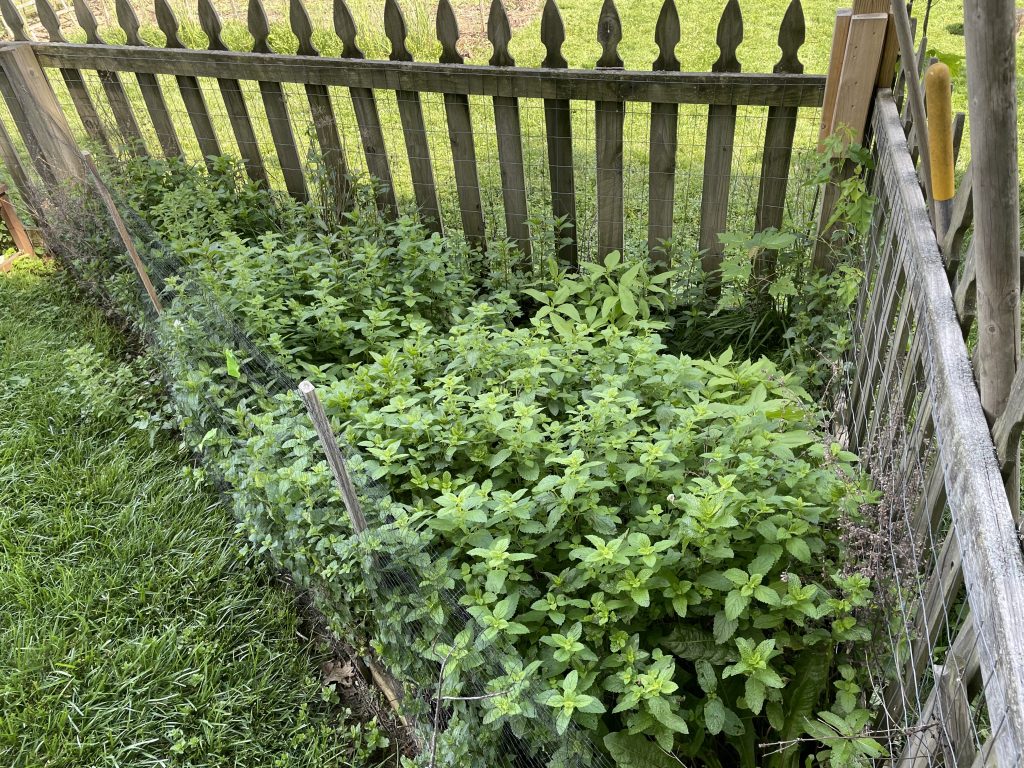The hops are blooming! I hadn’t planned to do any brewing, but I’m getting curious. Maybe I’ll soak some in a cheap beer and see how they impact flavor.

For now though, they’re just cool.
–Simon

Tales from Easement Acres
The hops are blooming! I hadn’t planned to do any brewing, but I’m getting curious. Maybe I’ll soak some in a cheap beer and see how they impact flavor.

For now though, they’re just cool.
–Simon


–Simon
Not when the integrity of my garden is at stake.
For weeks I’ve been watching this bastard groundhog mosey out of his cozy borough beneath my deck and take his thrice-daily constitutional into my garden and eat that which I’ve sowed.
Not noticeably an herbacious connoisseur, he ate everything from sunflowers to tomato plants. Every animal it seems must at some point sample a tomato plant, a plant that can’t taste very good. But they try it anyway and cause damage to my most prized vegetable, just to taunt me I think.

Unfortunately for them, while I might be a typical Disney-reared suburbanite, I’m also an experienced hunter with a mere respect and appreciation for wildlife. I don’t worship them as a FernGully fairy. It was time for lethal intervention. (And the fairies were more concerned about the trees anyway.)
Unfortunately, the statutes of my dear city of residence state:
672.09 DISCHARGING FIREARMS.
(a) No person shall discharge any cannon, pistol or other firearm, of any kind whatsoever, or any air rifle, pellet gun, gas gun, BB gun or other similar object within the City. This section shall not prohibit the firing of a military salute or the firing of weapons by men of the nation’s Armed Forces acting under military authority and shall not apply to law enforcement officers in the proper enforcement of the law; or to any person in the proper exercise of the right of defense; or to any person who has applied for and received special permission from the Manager to fire a cannon, pistol or other firearm, or air rifle, pellet gun, gas gun, BB gun or other similar object within the City.
(Ord. 50-71. Passed 7-12-71; Ord. 03-16. Passed 3-21-16; Ord. 04-16. Passed 4-18-16; Ord. 24-19. Passed 12-2-19; Ord. 23-20. Passed 11-2-20.)
(b) Whoever violates this section is guilty of a misdemeanor of the fourth degree.
(Ord. 59-74. Passed 7-15-74.)
https://codelibrary.amlegal.com/codes/centerville/latest/centerville_oh/0-0-0-9843
I wouldn’t want to be guilty of a misdemeanor of the fourth degree! The punishments are actually fairly draconian:
Fourth-degree misdemeanors carry a maximum sentence of 30 days’ jail time and a $250 fine.
https://www.criminaldefenselawyer.com/resources/ohio-misdemeanor-crimes-class-and-sentences.htm
I’d probably just have to do some community service, but still. Geez.
So I totally didn’t try to shoot it with a pellet gun.
I’m sad to see this also applies to bows. I can’t shoot a bow in my backyard. People are prudes.
Anyway, so after my non-existent attempts to shoot the groundhog failed to prove lethal, I resorted to trapping.

Of course, untargeted trapping can have undesirable results. But the possum was freed to continue raiding my compost.
Eventually, persistence and modified approaches yielded the desired results.

So endeth the groundhog saga. Freed from his mortal coil by means which totally didn’t involve a pellet gun, to raid the gardens of wherever dead rodents go in death.
Bastard.
–Simon
The industrialization of agriculture has been, without argument, very successful. It’s successful in that it produces large surpluses of high-calorie food. But it’s successful in that it’s effective, not necessarily efficient. Coop farming and companion planting have proven to be far more successful in the latter when measuring yield per acre, but subsidies motivate the former. Endless swaths of feed corn are not symptomatic of a natural symbiosis. Instead, they’re exploitative.
They’re also naturally particular. Plants that grow well in their original form, without genetic manipulation, are lower-yield but far less demanding of intervention. But the low yield excludes them from agriculture, as they are not cash crops. They are relegated to home gardens and their native environment. Forgotten or ignored. The province of hobbyists.
And as a hobbyist, it presents an unconventional opportunity: foraging. Or even more unusual: cultivated foraging.
First attempts at an herb garden were less than successful. The selected patch wasn’t nearly sunny enough for everything, and some of the initial selections turned out to be uncontrollable, e.g. mint. But the uncontrolled were still culinarily desirable, so they were left to be – picked as needed and then ignored.
Then I considered what else might fit with the patch? What else could compete alongside the verdant aggressors, hold their own, and still serve a purpose in the kitchen? Then I discovered the Jerusalem artichoke. A native, edible, perennial sunflower? That spreads wildly with few soil requirements? Sounded like a good candidate to me.
Apparently they’re still common in French cuisine (go figure), but fell out of general favor due to their affiliation with “poor people food”. Like cassava I guess. Perceptions drive people to make odd choices. Barbecue is technically poor people food, but you don’t find many elites snubbing their noses at it.
It’s also something that had to be sourced through online nerds, just like the hops. And true to their reputation, they started growing quick with little care.
Their name is a misnomer. They’re neither from Israel nor are they related to artichokes. And the tomato isn’t Italian, and the potato isn’t Irish. These are all American natives and I’m taking them back. Cultural appropriation countered!
On this continent, they’re more often called sun chokes. I briefly called them “Jew chokes” and “choke a Jews”, (I’m not feeling particularly pro-Semitic currently, what with the genocide and all), but settled on “feist chokes”, after the stupid dog kept eating and regurgitating them, prompting a net to be installed.

So now we have what I call the Forage Patch. It’s overgrown, resistant to organized cultivation, but all useful for food and drink, and all planted intentionally. It’s an unconventional approach to gardening, and falls more under the classic “kitchen garden”, rather than the “victory garden” concept, but it’s proving to be useful regardless. I’ll be curious how the feist chokes cook up.
–Simon
The Reinheitsgebot of 1516 represents what only a most civilized society could mandate. It is a perfunctory requisite, in its raw essence, but it permits our modern world to exist, for who would haven given it a second thought were the market not now saturated with fruit-infused abominations? Law and order, dammit! Advanced political discourse cannot take place on massive social policies without something to drink. If you disagree, you’re un-American.
Okay, maybe that’s not fair to our Islamic community. I’ll forgive you for your other culinary contributions.
I speak of course of beer! Even though I usually prefer bourbon (something infinitely more American). Which, now that I think about it, beer isn’t really American at all. It’s a cultural inheritance from northern continental Europe – and from second-class immigrants at that. If OG blue-blooded Americans are WASPs, then British carryovers would define American beverage culture. And I think the British were more into hard apple cider at the time than beer. And we like that too. And we made it better by creating applejack, which is not the same as Calvados, even without the “appellation d’origine contrôlée”. Calvados is sweet sissy apple syrup. Applejack is for real Americans! Pioneering Americans. The fuck you Americans! Raaah!
Okay, so bourbon and applejack are the most American of intoxicants. But we like beer too. And to show my appreciation, I have planted hops! Also, to out-do my father-in-law, because he started growing them first and I couldn’t allow him to be successful at gardening something I hadn’t yet tried.

They’re one of those plants that’s oddly difficult to find through traditional distributers, e.g. Burpee’s, but very easy to find through any gardener with an internet connection. A couple weeks later I had some rhizome cuttings that very quickly took to my sunny fence corner.
They’re not very big yet, but growing quickly. And while I have no plans for home-brewing, I’ll appreciate the coolness factor. And doing a better job than Liz’s dad. And for my ancestors.
Drink your sissy Zimas and Smirnoff Ices. And Calvados.
–Simon